MARIANI’S
Virtual
Gourmet
January 17,
2016
NEWSLETTER

"Girl
Peeling Potatoes" (circa 1890) by Albert Anker
IN THIS ISSUE
SAYBROOK POINT INN & SPA
By John Mariani
ABOUT THAT, UH, REVEW OF PER SE AND WHAT IT DOES
AND DOES NOT SAY ABOUT FINE DINING TODAY
By John Mariani
NEW YORK CORNER
ELM
By John Mariani
NOTES FROM THE WINE CELLAR
WHAT I'M DRINKING NOW
By John Mariani
❖❖❖
SAYBROOK POINT INN & SPA
By John Mariani

Sometimes,
when feeling lazy,
writers fish for some other writer’s brilliant
quotation to open an article,
and I admit I looked far and wide to find one
about the Nutmeg State, but came
up real short.
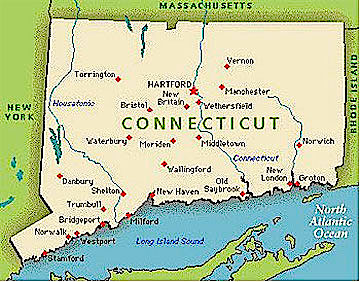 Not even
the Yale
Book of Quotations offers a single
remark about Connecticut, though it has two on
Ohio. And the state motto—Qui
transtulit sustinet (“He who transplanted
sustains”)—must be the least
inspired in the Union. Not even
favorite daughter Katherine Hepburn or Missouri
emigré Mark Twain ever said anything noteworthy
in print
about their state.
Not even
the Yale
Book of Quotations offers a single
remark about Connecticut, though it has two on
Ohio. And the state motto—Qui
transtulit sustinet (“He who transplanted
sustains”)—must be the least
inspired in the Union. Not even
favorite daughter Katherine Hepburn or Missouri
emigré Mark Twain ever said anything noteworthy
in print
about their state.
So let me try:
Connecticut is Hollywood’s ideal of New England at
its prettiest, its richest
and its smartest—rather like Hepburn herself—with
movies centered on
picturesque country homes and inns in films as
disparate as “Christmas in
Connecticut,”  “Bringing
Up Baby,” “Mr.
Blandings Builds His Dream House” (left),
“Parrish,” “Summer Stock,” “The Awful Truth,”
even “Beetlejuice” and “The
Stepford Wives.”
Such idealization
is not without foundation, most beautifully evident
in eastern Connecticut
towns like Essex, Old Lyme and Old Saybrook, all
easily visited over a weekend.
“Bringing
Up Baby,” “Mr.
Blandings Builds His Dream House” (left),
“Parrish,” “Summer Stock,” “The Awful Truth,”
even “Beetlejuice” and “The
Stepford Wives.”
Such idealization
is not without foundation, most beautifully evident
in eastern Connecticut
towns like Essex, Old Lyme and Old Saybrook, all
easily visited over a weekend.
Old
Saybrook, which is principally one long Main Street,
dates back to 1624, with Dutch
origins, then as Saybrook Colony in 1635 it came
under English rule.
In 1701 the Collegiate School of
Connecticut was chartered there, before moving to
New Haven a decade later to
become Yale University.
In 2009 the town fathers
converted the old town hall to the Katharine
Hepburn Cultural
Arts Center and Theater (right). Kate
lived in nearby Fenwick, and my wife and  I were delighted to stay in a cozy,
fireplace-warmed room named after the great lady at
the Saybrook
Point Inn and
Spa, which has been recently restored
and expanded with a main house, a large guest house
across the road, and a
marina, all of them set on the edge of the
fast-running Connecticut
River and Long Island
Sound.
I were delighted to stay in a cozy,
fireplace-warmed room named after the great lady at
the Saybrook
Point Inn and
Spa, which has been recently restored
and expanded with a main house, a large guest house
across the road, and a
marina, all of them set on the edge of the
fast-running Connecticut
River and Long Island
Sound.
The Inn has been here
for 130 years and for a while back in the last
century had a rep as a popular
spot for show biz stars and mobsters to get far away
from it all, thereby
lending the Inn a notorious glamour.
But it’s always been an elegantly appointed
place drawing guests from
all over the U.S. and, increasingly Europe and South
America. With
a seasoned pro named John Lombardo
as new general manager, a
state-of-the-art Sanno Spa and indoor pool,
conference and banquet facilities,
and a renovated and reconfigured restaurant called
Fresh Salt, the Inn has
never been better run or maintained.
 The
Hepburn Suite (left) is
in Three Stories, an Italianate Victorian home with
eight rooms, each with a
private balcony, exquisite furnishings that marry
New England tradition to all
the modern comforts (including a large bathroom with
heated floors, separate
bath and shower), and a full breakfast each morning.
The
Hepburn Suite (left) is
in Three Stories, an Italianate Victorian home with
eight rooms, each with a
private balcony, exquisite furnishings that marry
New England tradition to all
the modern comforts (including a large bathroom with
heated floors, separate
bath and shower), and a full breakfast each morning.
We enjoyed a fine
dinner at Fresh
Salt, somewhat more casual than it used to
be, so there are
now a lot more sweaters than blue blazers in the
dining room. Like
everywhere else at the Inn, Fresh
Salt looks out on the water, and as the days grow
longer, the twilights are
earlier, the sunsets later, making it an ideal place
to dine in the area,
whether or not you’re staying at the Inn.
My wife and I began with Raw Bar
offerings in the form of yellowfin tuna sashimi (below) with
wonton matchsticks, creamy
avocado, ginger soy dressing, mango salsa and
cilantro ($14.95); delicious, if
a little overdressed.
There are
other Asian elements on the menu, such as crisp
calamari with a sweet Srirachi
chili glaze, spicy cherry peppers and julienne of
fresh vegetables and
scallions ($13.95).
A Mexican note
was found in the juicy duck confit nachos with
pear-tomato concasse,
micro-arugula greens and Connecticut goat’s cheese,
with a port reduction and
crispy wonton ($12.95). You’ll
find a great proportion of ingredients used are from
Connecticut and New
England.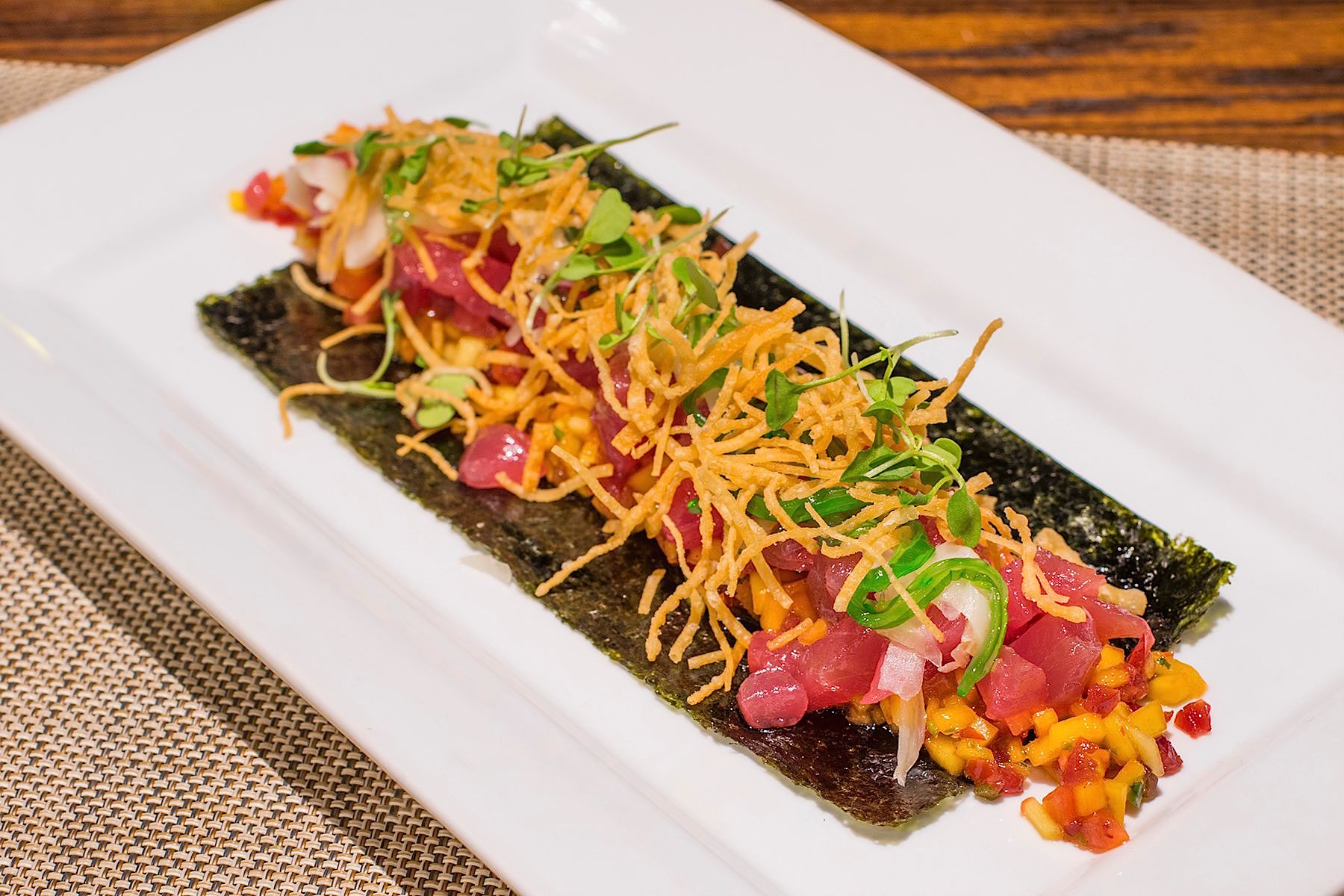
We managed to sample
three main courses, and portions are very generous. We raved about a dish called
Swordfish “Mrs. Tag” style
($29.95), which began with superb swordfish glossed
with good olive oil, garlic,
a little lemon zest, Italian parsley and fine
breadcrumbs, with a
Parmesan-spinach risotto and sautéed zucchini—again,
a bit of piling on the
plate, but it really was a terrific dish in all its
components.
Their devotion to
Connecticut ingredients aside, chef John Cortesi and
chef de cuisine Gese
Rodriguez are to be applauded for using Colorado
lamb. Pork osso
buco ($25.95)
came with a well-wrought polenta sweetened with figs
and sided with field
mushrooms and a truffle sauce.
One assumes that at
any time of year New England desserts (below) are
going to be homey and irresistible,
and pastry chef Stephanie Schroeder’s do not
disappoint. “Indoor S’mores”
($9.95) are made with housemade marshmallows, Graham
cracker cookie, salted
caramel sauce and chocolate Bavarian cream; a
vanilla-scented 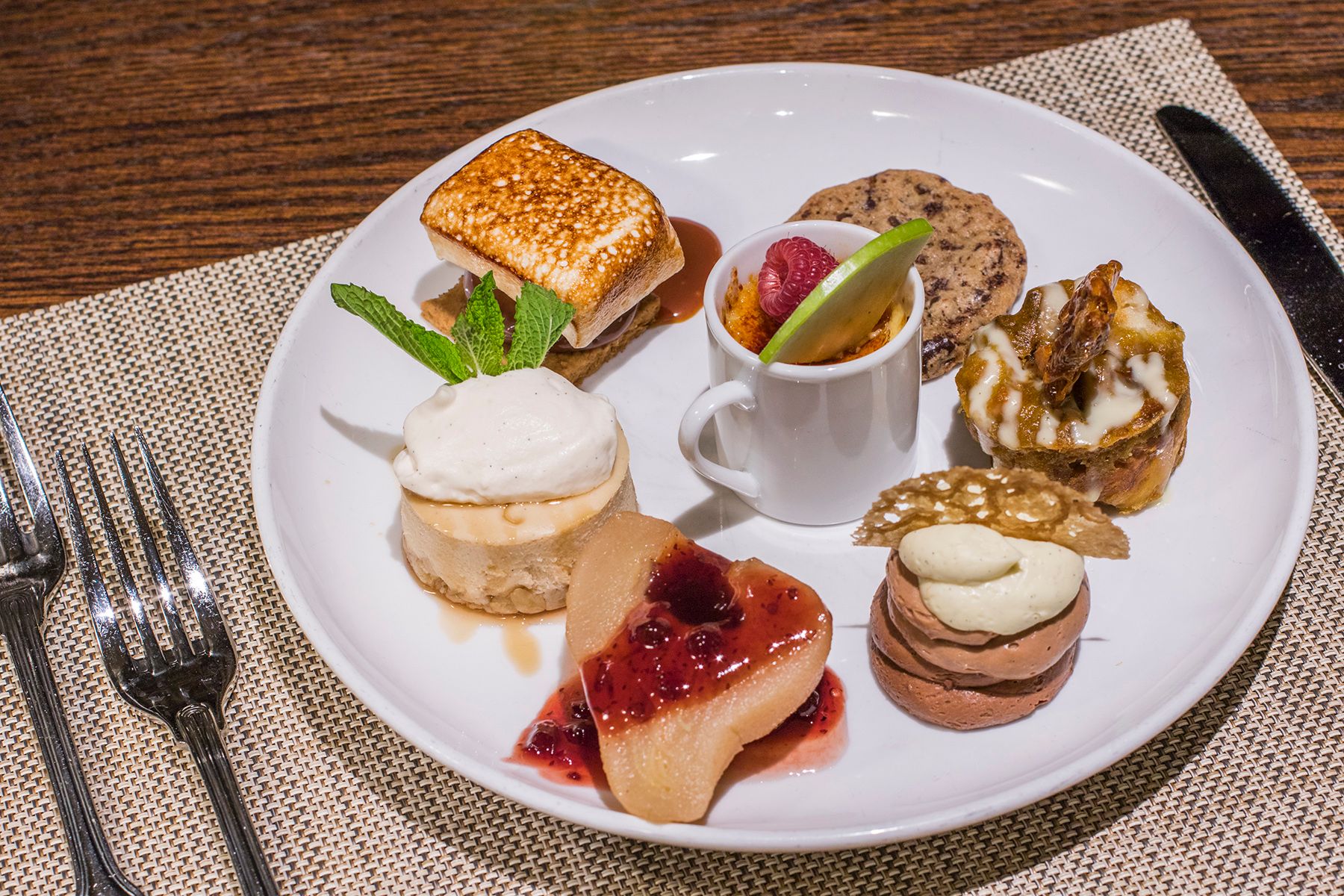 poached winter
pear with a Cassis reduction ($8.95) and a ricotta
maple-laced cheesecake
($9.95) were wonderful, but you might just want to
go with the three chocolate
chip cookies dipped in white chocolate ($7.95). Then sit back and enjoy a cup
of cider laced with Jack
Daniels honeyed whiskey.
poached winter
pear with a Cassis reduction ($8.95) and a ricotta
maple-laced cheesecake
($9.95) were wonderful, but you might just want to
go with the three chocolate
chip cookies dipped in white chocolate ($7.95). Then sit back and enjoy a cup
of cider laced with Jack
Daniels honeyed whiskey.
Mr. Lombardo is duly
restocking what is now a modest wine list, whose
prices are very fair and
include some Connecticut spirits and beers. The
liquor list is a good one, with
eight bourbons and six single malt Scotches.
I’m sure
the late
Grande Dame Hepburn, who swam in the Sound every
day, would have approved of
the room named after her and might even have
recommended the Inn for a location
wherein to shoot a Hollywood movie in rooms once
frequented by her peers. If Hollywood don’t make ‘em
like they
used to—Kate Hepburn included—the Saybrook Point Inn
certainly does its best to
epitomize all the old charms and elegance of a state
that deserves a
much livelier motto.
❖❖❖
ABOUT THAT, UH, REVEW OF PER SE AND WHAT IT DOES
AND DOES NOT SAY ABOUT FINE DINING TODAY
By John Mariani
 VS
VS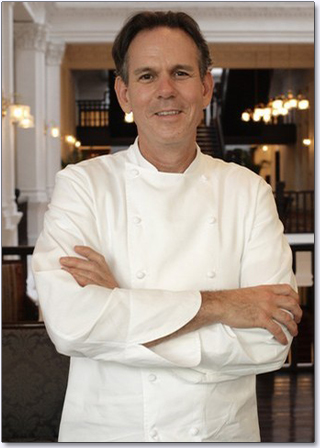
As apparently
everyone in the world knows by now, NY Times
restaurant critic Pete Wells
dropped the acclaimed Thomas Keller-owned
restaurant Per Se from four (extraordinary)
to two (very good) stars, though the review’s
nastiness read more like it
deserved zero stars.
I’m not going to rebut anything
Wells said about individual dishes I
have not tried, but I do wish to weigh in on what
has become a thorny issue
among the media and food world, many of whom seem to
want “fine dining” to go
away and just die.
Others question
how, even without ordering the most expensive wines
or surcharged items on Per
Se’s lofty list, it is justified to spend $3,000 for
four people, as did Wells,
even if
the amuses, courses, extras, petit fours
and takeaway pastry total more
than a dozen dishes over four hours.
So do I. There
comes a
point at which the expenditure of an astonishing—I
deliberately didn’t say
outrageous or obscene--amount of money on one meal
becomes a question of things
getting way out of hand in today’s entertainment
world--and I did
deliberately say entertainment. For me it
is not a question of whether
a person can afford and does choose
to spend so much money (and most people who dine at
Per Se spend much more than
Wells did) for a single meal.
Some will just shrug and say, if a person has
the money and spends it on
exorbitant multi-course
dinners
it’s his right to do so. I don’t
find it a question of morality, I find it a question
of gross, show-off excess
and gluttony, which is, of course, based on the fact
that restaurants like Per
Se, Eleven Madison Park, Masa, Momofuku Ko, Brooklyn
Fare, and Blanca, all in
NYC, appeal only to such people.
(O.K, we all know a couple that saved their
pennies for two years, blah,
blah, blah. . . .)
My point is not the expenditure
itself but the one-upmanship behavior
of chefs and restaurateurs who believe that more and
more and more is always
better, and that there are always enough people to
gulp it down: the last meal
at the now-closed, said-to-be money-losing El Bulli
in Spain was fifty courses
served over seven hours and was a ticket tougher to
get than if Joe Louis had
been brought back from the dead to fight a
reinvigorated Muhammad Ali.
 You can spend plenty of
money at a Michelin three-star restaurant in
Paris, but the meal amounts to four, perhaps five
courses and is priced
accordingly. For the record, when Thomas Keller,
whom I still place in the top
ranks of the world’s chefs, opened Per Se many years
ago, I did not
include it among my “Best New
Restauarants” that year because I believed that a
restaurant whose chef refuses
to allow his guests to have any say or leeway in the
choosing of their meal is
not truly a great restaurant. The
customer is not always right, but neither is the
chef.
You can spend plenty of
money at a Michelin three-star restaurant in
Paris, but the meal amounts to four, perhaps five
courses and is priced
accordingly. For the record, when Thomas Keller,
whom I still place in the top
ranks of the world’s chefs, opened Per Se many years
ago, I did not
include it among my “Best New
Restauarants” that year because I believed that a
restaurant whose chef refuses
to allow his guests to have any say or leeway in the
choosing of their meal is
not truly a great restaurant. The
customer is not always right, but neither is the
chef.
Per
Se, like
a handful of other restaurants around the country
that have copied its method
of operation, is made for those people Oscar Wilde
defined as “cynics, who know
 the price of everything and the value
of nothing.” They are restaurants for those
who prefer Kim Kardashian to
Grace Kelly, Dolce &
Gabbana
to Savile Row,
Las Vegas to
Paris. Words
like “refinement,” “taste”
and “elegance” have given way to exclamatory
words like “awesome!” “over-the-top!” and
“unbelievable!”
for people who have no clue what the difference
between fashion and style is.
the price of everything and the value
of nothing.” They are restaurants for those
who prefer Kim Kardashian to
Grace Kelly, Dolce &
Gabbana
to Savile Row,
Las Vegas to
Paris. Words
like “refinement,” “taste”
and “elegance” have given way to exclamatory
words like “awesome!” “over-the-top!” and
“unbelievable!”
for people who have no clue what the difference
between fashion and style is.
But
Wells’s review was not really about excess or about
the death of
fine dining; indeed, as far as we know, he still
adores Masa, Eleven Madison
Park, Blanca, and Momofuku Ko. It
was more of a bludgeon to a restaurant whose food
and service should have been
perfect for the expenditure of that kind of money
and time and clearly wasn’t. Had
everything been delicious and
impeccably served, Per Se would gave retained its
four stars.
But for the rest of us, without
the largess of the Times, the
expense account of a Goldman Sachs
CEO, or the bulging pockets of a Russian
billionaire, Per Se represents not a
drift or complacency but gives reason to re-think
what fine dining truly
is: For catering to the guest is
paramount among the reasons one
dines at restaurants that have invested enormous
amounts of money and time to
make an evening out an enchantment, in a dining room
where guests feel not just
welcomed but special and warmly happy without having
to endure the dictates of
an ego- and media-driven chef whose childish
attitude is, “This is my
restaurant and I’ll do things the way I want to!”
Make no mistake, fine dining
flourishes, but it does so only when the
food, wine, service, linens, lighting, sound, color,
temperature, menus,
silverware, glassware, reception and thank-yous all
conspire to make a guest
feel he or she has been part of something very
special at a time when the
tawdry and the banal are being mistaken for class
and quality.
By John Mariani
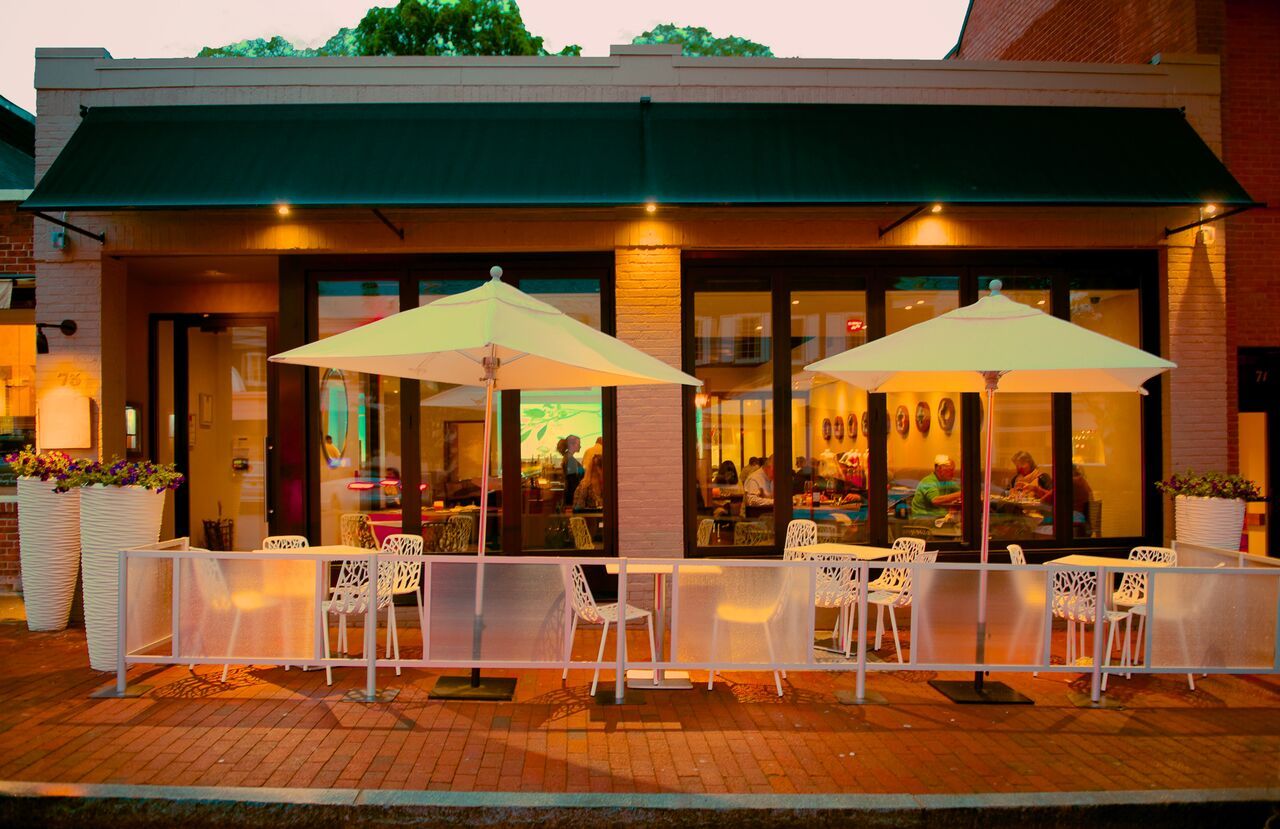 ELM
ELM73 Elm Street
New Canaan, CT
203-920-4994
www.elmrestaurant.com
Connecticut towns like
Old Saybrook, Essex, and
Lyme lie too far north of New York to be called
bedroom communities, but New
Canaan, 45 miles and 65 minutes by train from
Grand Central, most certainly is—and
it’s also the eighth wealthiest suburb in the
U.S. at that.
Dating
back
to 1731, the 22-square-mile town has many of the
same bucolic charms of those
to the north, but New Canaan’s real estate values
are in the stratosphere for
the old colonials, the pre- and post-war mansions,
and modernist houses built by architects
like Marcel
Breuer
and resident Philip Johnson, whose famous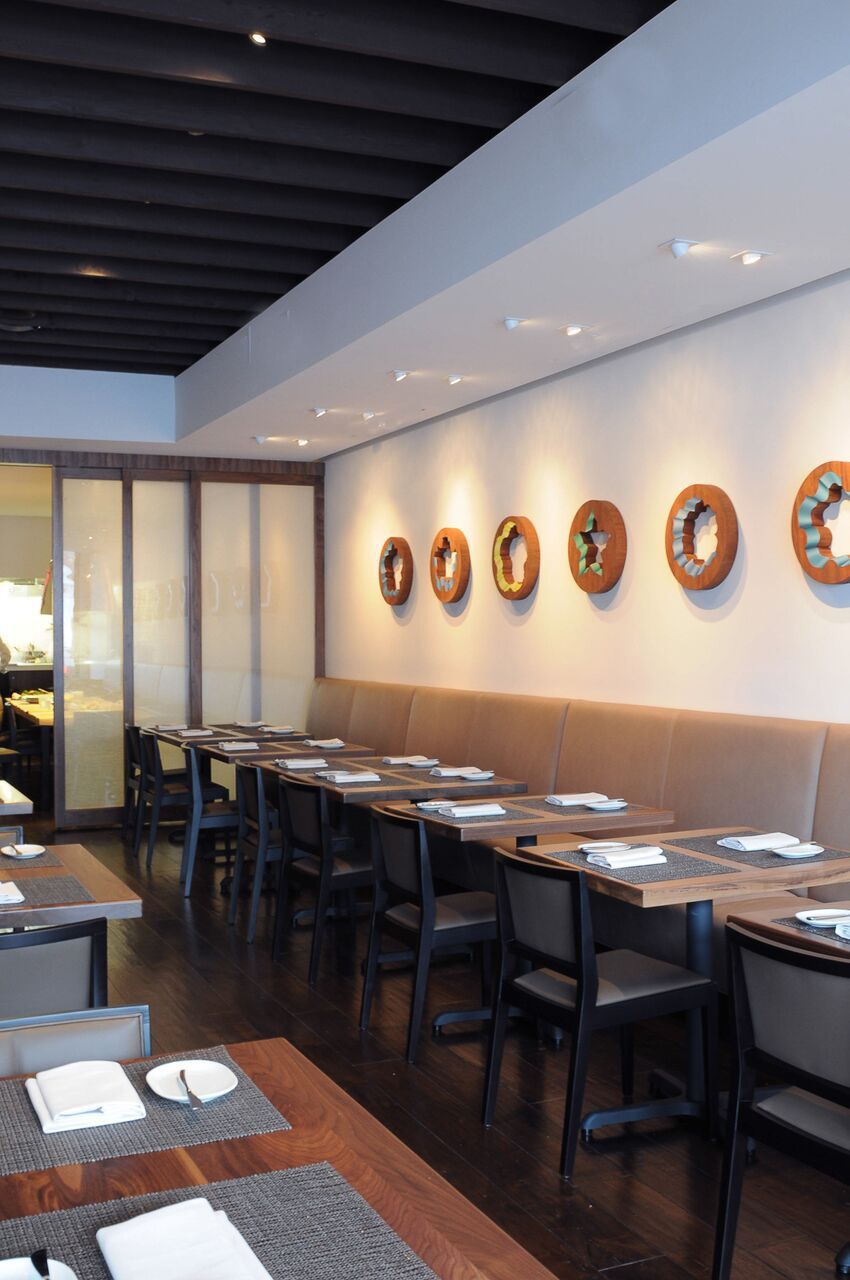 Glass House is here.
Glass House is here.
The very tidy town center is
mostly filled with
Georgian-style red brick structures, and Elm
Street, lined with the requisite
trees, is a stretch of upscale
boutiques, a movie house, and one of the
finest restaurants in the
state, which takes its name from the street. When Elm opened in 2012, the
chef-partner, Brian Lewis, was
a star on the rise whose cooking I praised; he
left in 2014 and this year just open his own new
restaurant in Westport named Cottage, which I
shall be reporting on soon.
 His
replacement at Elm, Luke Venner (left), is a
formidable choice, with his own style but one that
has always characterized the
restaurant’s kitchen, sharply focused on the
seasons and the provender
available, particularly if it’s from New England's
land and waters, with
purveyors like Millstone Farms in Wilton and
Smith’s Acres in Niantic, listed
on the menu.
Venner, a bearded
South Dakotan, comes to Elm after stints at NYC’s
BLT Fish and BLT Steak, and he’s kept on a number of the
old menu's categories, from snacks to
desserts (eating at the bar is very
popular here, and the bartender is
first-rate).
He’s also kept the
homey touches like serving warm Parker House rolls
with soft butter.
His
replacement at Elm, Luke Venner (left), is a
formidable choice, with his own style but one that
has always characterized the
restaurant’s kitchen, sharply focused on the
seasons and the provender
available, particularly if it’s from New England's
land and waters, with
purveyors like Millstone Farms in Wilton and
Smith’s Acres in Niantic, listed
on the menu.
Venner, a bearded
South Dakotan, comes to Elm after stints at NYC’s
BLT Fish and BLT Steak, and he’s kept on a number of the
old menu's categories, from snacks to
desserts (eating at the bar is very
popular here, and the bartender is
first-rate).
He’s also kept the
homey touches like serving warm Parker House rolls
with soft butter.
The
slender space is bisected, with a bar to
the left and main dining room to the right, with a
bright open kitchen to the
rear, and it can get extremely loud when packed. The lighting is kind to
everyone, though the décor is
minimal, the tables unadorned, which doesn’t help
the decibel level.
The crowd is largely composed of locals
with a heightened sense of what food in the ‘burbs
could and should
be, which is the polar opposite
of what’s being served in the area’s country
clubs. Indeed, Venner’s
cooking reminds me of that at the
much heralded Nomad in NYC.
The night I visited, the
kitchen was blessed
with bay scallops,
which were served proudly raw and delicately
sweet. Burrata
had a
creamy center, dressed with an interesting pesto made
from pulverized
nasturtiums, set on grilled bread ($18).
 Tuna
tartare with Subarashi pear, radish and soy
mustard ($21) was
nicely seasoned and of good texture, but an
otherwise fine pumpkin and apple
soup ($14) was ruined by the strong taste of
smoked bluefish.
Tuna
tartare with Subarashi pear, radish and soy
mustard ($21) was
nicely seasoned and of good texture, but an
otherwise fine pumpkin and apple
soup ($14) was ruined by the strong taste of
smoked bluefish.
There were two excellent pastas
on the menu—a carnaroli risotto
with black truffle and
mascarpone ($26) that could not be improved upon
for its simple elegance and
richness, and a rigatoni with spicy, hot ‘nduja-riddled
bolognese
sauce dusted with
Parmigiano ($24).
So often these days black
bass—or bass of any
kind—is a disappointment, sometimes not even bass,
but Venner’s had all the
flavor you could wish for, along with Littleneck
clam broth, a little tarragon
and a hit of wasabi to brighten it all ($34). Just as wonderful was his
breast of duck with rye dumplings
and a Saskatoon berry jus ($36), as good a cold
weather dish as you’ll find,
and I loved the marriage of flavors in
the Mangalitsa pork confit with spiced
carrot and chimichurri
($34). As
the simplest of
dishes on the menu, Venner’s hanger
steak delivers in chewy texture and juiciness,
served with roesti potatoes,
charred chard and a nice dollop of cool sour cream
jus ($36). I did not
try the grass-fed beef burger with raclette cheese
and Russian dressing ($18)
because it is
from insipid grass-fed beef.
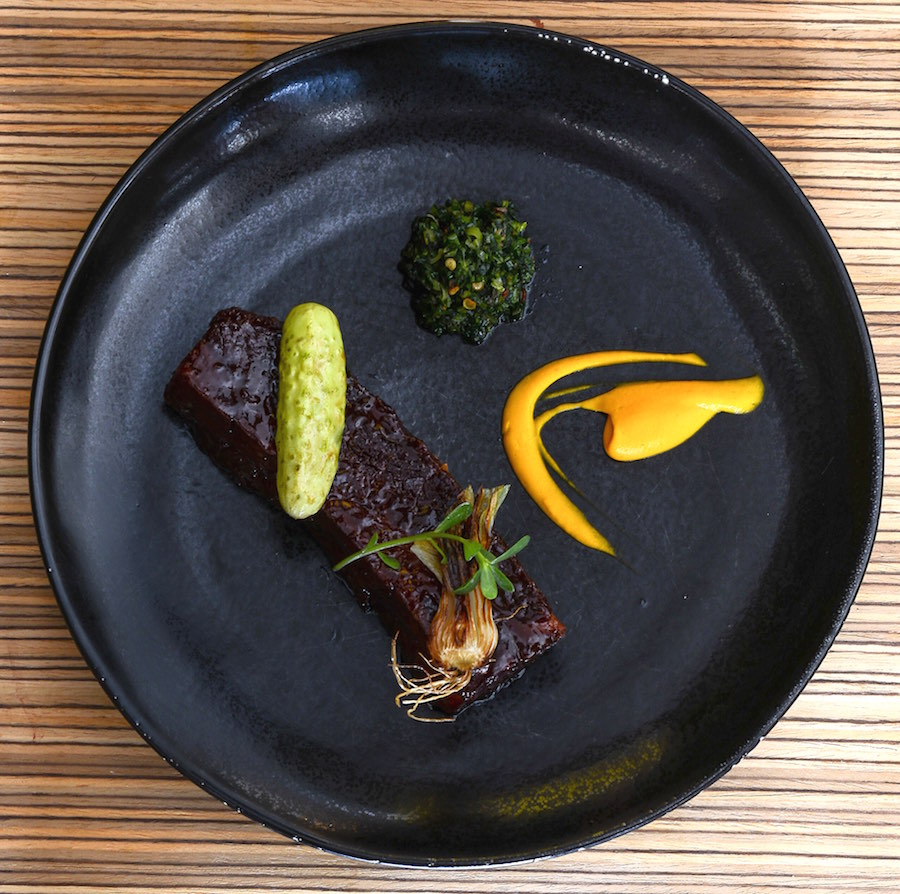 Pastry
Chef Kara
Koehmstedt, recently of NYC’s progressive
restaurant Cosme, turns out
exceptionally good desserts (all $8) that balance
the homey, seasonal qualities
of the area with real finesse, as evidenced in her
poached plum with oat cake,
plum ice cream, and mascarpone cream;
a pumpkin cheesecake with crunchy crumble
and white cheese mousse; a
dense but moist chocolate cake with chocolate and
orange cream, and “dream
sickle” ice cream; and good old-fashioned Italian
zeppole fritters
filled with
ricotta and served with jam and maple ice cream.
Pastry
Chef Kara
Koehmstedt, recently of NYC’s progressive
restaurant Cosme, turns out
exceptionally good desserts (all $8) that balance
the homey, seasonal qualities
of the area with real finesse, as evidenced in her
poached plum with oat cake,
plum ice cream, and mascarpone cream;
a pumpkin cheesecake with crunchy crumble
and white cheese mousse; a
dense but moist chocolate cake with chocolate and
orange cream, and “dream
sickle” ice cream; and good old-fashioned Italian
zeppole fritters
filled with
ricotta and served with jam and maple ice cream.
Elm’s wine list is robust, has
depth and is
very pricey.
You can find this quality of
food in Manhattan,
but it’s still rare in the city’s suburbs, and
rarer still to find any up there
that can match the beautifully balanced cuisine at
Elm.
Elm is open for lunch
Mon.-Fri.; dinner nightly; brunch Sat. &
Sun.
❖❖❖
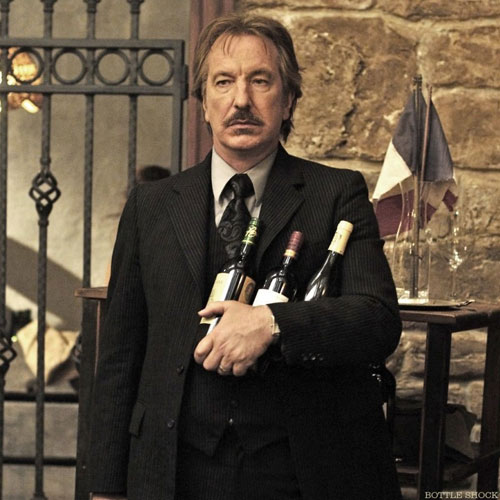 NOTES FROM THE WINE
CELLAR
NOTES FROM THE WINE
CELLARWHAT I'M DRINKING NOW . . .
BOTH GOOD AND NOT SO GOOD
BY JOHN MARIANI
It’s
become something of a problem that I’m finding
more and more wines either
flawed (corked, oxidized, incomplete malolactic)
or just not very good to begin
with. The
corked or oxidized wines
may in fact be just one bad bottle or the whole
batch. Poor
or badly made wines, on the other
hand, are what they are, and their increase has
become so chronic that I’ve
started to bring two different wines to my dinner
table each night, so that if
one turns out to be of poor or flawed quality I
just open a different wine and
hope for the better. (The bad bottle I taste the
next day to make sure.)
So, here are a slew of
wines I’ve been either enjoying or finding to be
not worth drinking.
Others are so intentionally stylized to
taste a certain way that they are worth mentioning
for that alone.
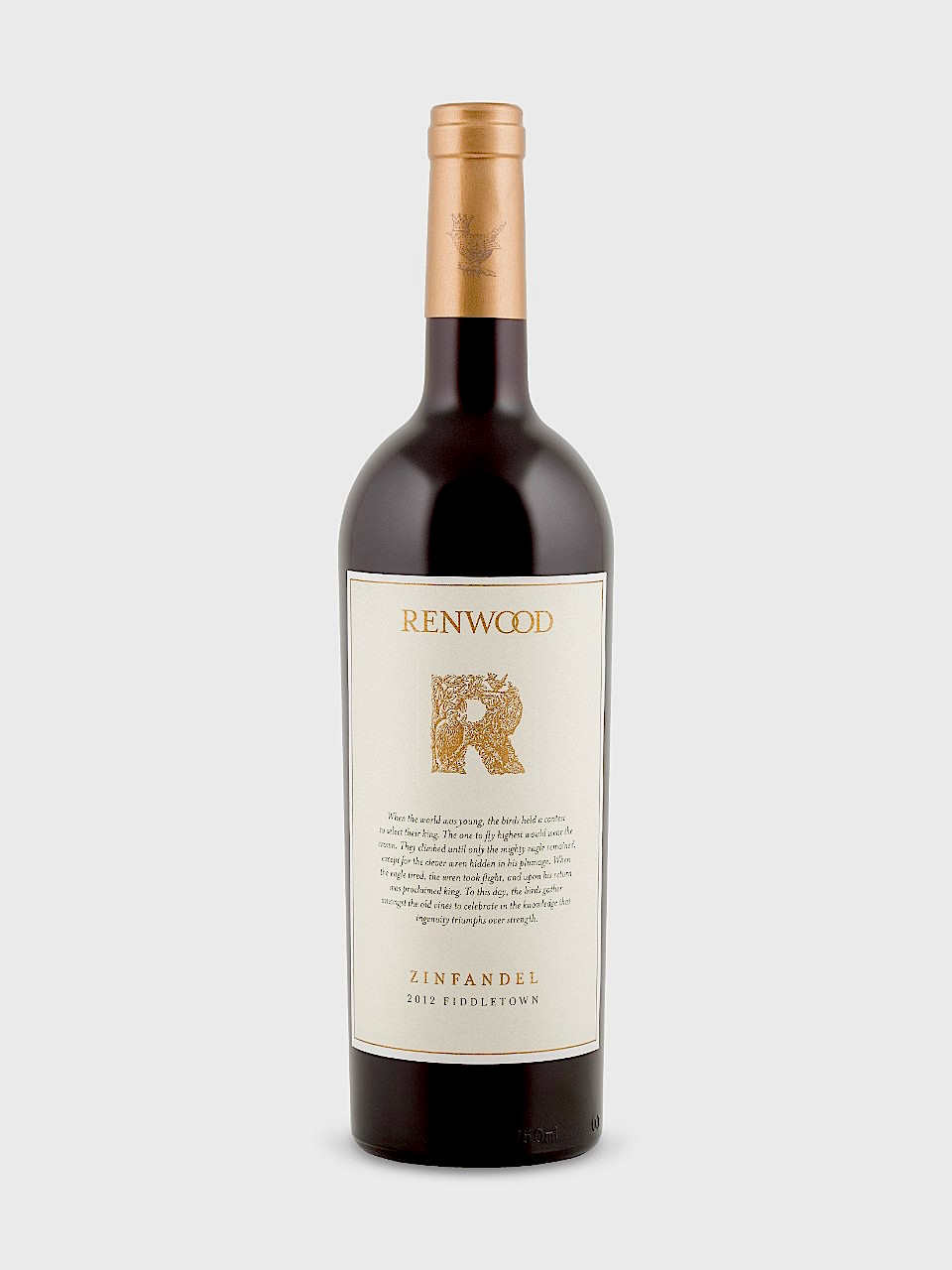 Renwood Zinfandel
Fiddletown
2012 ($25)—Like
Longfellow’s little girl with the little curl,
Zinfandel can be either very
good or very bad.
Renwood makes a
wide array of zins, and this well-priced example
from the Sierra Foothills has
the boldness and boot to please those who love the
varietal. With
94% Zin, 5% Syrah and 1% Petite
Syrah, the cherry fruit notes provide a delicious
added incentive to drink this
wine with dishes that have a bit of sweetness,
like the pork ribs with a guava
glaze my wife made last night. The 14.5% alcohol
is commendable in a varietal
that too often goes way higher.
Renwood Zinfandel
Fiddletown
2012 ($25)—Like
Longfellow’s little girl with the little curl,
Zinfandel can be either very
good or very bad.
Renwood makes a
wide array of zins, and this well-priced example
from the Sierra Foothills has
the boldness and boot to please those who love the
varietal. With
94% Zin, 5% Syrah and 1% Petite
Syrah, the cherry fruit notes provide a delicious
added incentive to drink this
wine with dishes that have a bit of sweetness,
like the pork ribs with a guava
glaze my wife made last night. The 14.5% alcohol
is commendable in a varietal
that too often goes way higher.
Amapola Creek Zinfandel Monte
Rosso Vineyard 2009
($36)—As I
just said, zins can go into the alcoholic
stratosphere, and this Sonoma example
sure does, at 16.1 percent. The wine is massive in
an overwhelming way and
tastes like cherry syrup rather than a fine wine. Richard Arrowood has always
made zins in this style, dense
to the point of being cloying.
This might work, as would Port, which has
20% alcohol and sweetness,
with some French triple-cream cheeses.
Red Rock Winery Malbec Reserve
2012 ($13.99)—Over the
past few years Malbecs have been among the most
impressive wines coming out of
Argentina, but now, it seems, following that
recognition, the onslaught of
lesser examples has begun, as when bad pinot
grigio flooded the market after
the first really good examples showed that Italian
varietal’s best side. Red
Rock gets its name from red rocks that point the
way to the winery in Mendoza,
and it appears to be a deliberate choice to be in
English for the American
market. But
the flavors are
overripe, cloying and out of balance, without
saying anything about Malbec’s
own particular flavor or Mendoza tarroir.
Joseph Drouhin Vosne-Romanée
2012 ($80)—I almost hated myself for opening this
vintage
so soon, but, with a Christmas goose on  the table I couldn’t
resist, and it was
a magical marriage.
This is what a
Burgundian Pinot Noir is supposed to taste
like—elegant, velvety, with a fruit-acid
balance that will only become richer in a year or
two. The
wine was aged for 14 to 18 months
(20% new oak), which softened rather than affected
the flavor too much. The tannins are already
soft, and I‘m
already looking forward to next Christmas.
the table I couldn’t
resist, and it was
a magical marriage.
This is what a
Burgundian Pinot Noir is supposed to taste
like—elegant, velvety, with a fruit-acid
balance that will only become richer in a year or
two. The
wine was aged for 14 to 18 months
(20% new oak), which softened rather than affected
the flavor too much. The tannins are already
soft, and I‘m
already looking forward to next Christmas.
Gap’s Crown Vineyard Three
Sticks Pinot Noir 2013
($65)—Younger still than the Vosne-Romanée, this
Sonoma County Pinot Noir shows
off the mid-weight of the varietal from a warm
climate. It’s what California
Pinot Noir should
taste like, rather than an imitation of a
Burgundy. It’s a little pricey—this is
only the estate’s second
vintage—but the year had a near perfect climatic
confluence of heat and cold,
rain and dryness.
There’s good
spice here and an admirable 14.1% alcohol level.
Presqu’ile Vineyards
Chardonnay
2013 ($45)—The name
means “almost an island,” referring to a spot
owned for generations by Matt
Murphy’s family in the Gulf Coast pretty much
destroyed by Hurricane Katrina in
2005. The 200-acre winery, in California’s Santa
Maria Valley, dates only to
2006, but already it’s producing delicious,
well-rounded, silky Chardonnay
under enologist Anna Murphy (Matt’s sister). The valley’s cool breezes
and modest rainfall help keep the
grapes in equilibrium (85% of the grapes used are
from the estate), and their
choice of clones makes their Chardonnay bright
with acidity and refined fruit
flavors without the overuse of oak that would make
it taste like caramel candy.
Chȃteau Genins 2013
($11)—More and more I’m happy to see such
wonderful,
low-priced Bordeaux come into the U.S. market, and
this example, with its
quaint old label, is the kind of red blend that
the people of Bordeaux drink on
an everyday basis.
It shows off
the clay and limestone soil components of the
region, is medium-bodied, has an
easy-to-drink 12% alcohol, and can be enjoyed with
anything (except seafood)
you might put on your dinner table tonight.
Petit Chapeau Bordeaux 2013 ($11)—A
blend of 60% Merlot, 20% Cabernet Franc, and 20%
Cabernet Sauvignon from the
Entre-Deux-Mers region, this is said to be from a
single estate, though that
info is not printed on the back label.
Yet, despite being a Daniel Johnnes
Selection (Johnnes is one of the
world’s most respected sommeliers), this is a
depressingly dull red wine at a
time when similar Bordeaux from lesser regions are
showing an admirable new
character (see Château Genins above).
It has very little taste at all and
certainly none of Bordeaux; not a
terrible wine, just not much of a red wine at all.
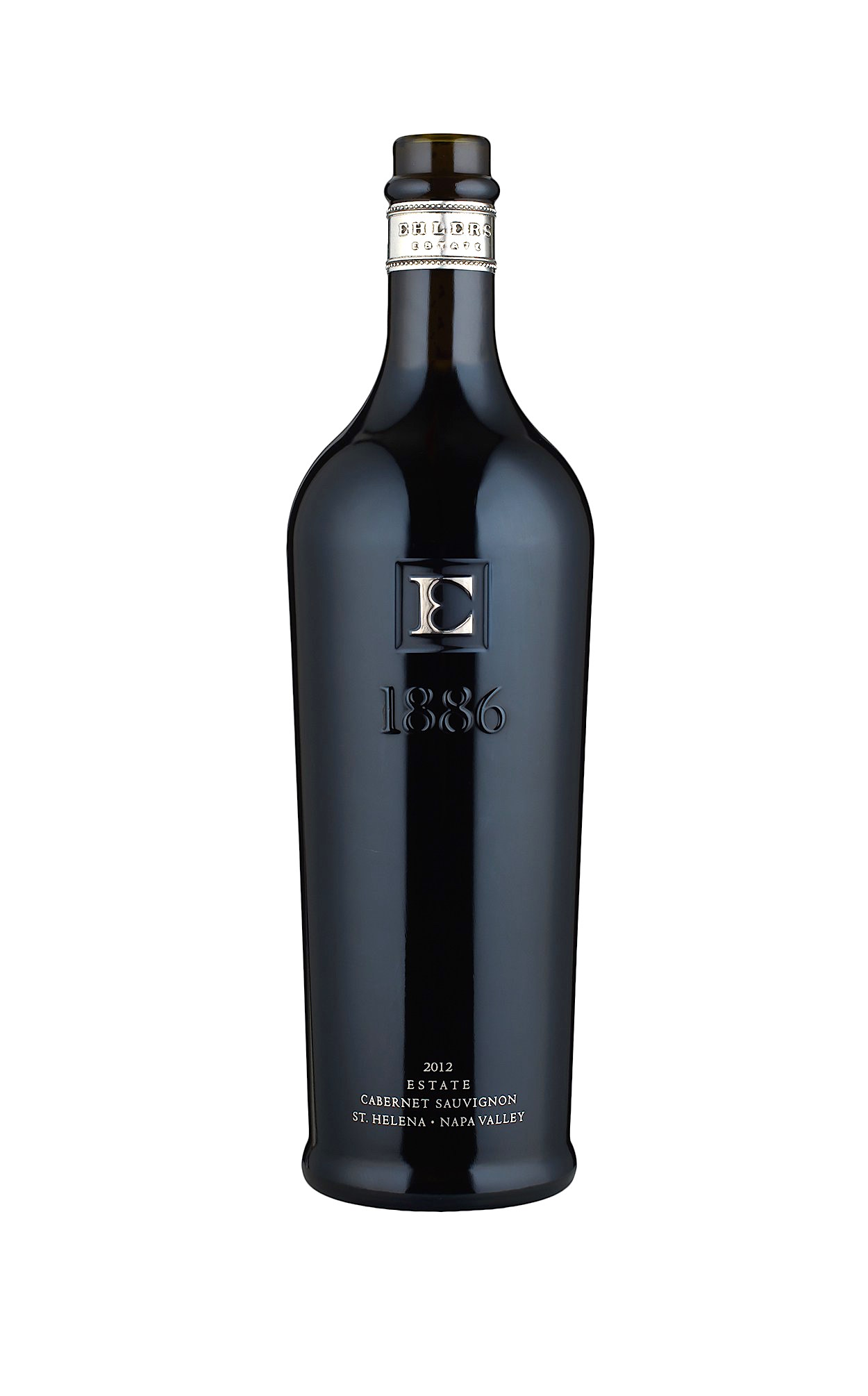 Ehlers
Estate E 1886 Cabernet
Sauvignon 2012 ($100)—When wines
arrive in thick-walled, heavy bottles with special
closures, I tend to think
there might be more in the packaging than inside,
but Bernard Ehlers winery
dates to 1886 and this 2012 vintage shows its
breeding. At
14.5% alcohol it hits that
California sweet spot above which Cabernet
Sauvignon gets treacly. Instead, the tannins are
soft, the
fruit pronounced but not syrupy, and it is just
begging to be drunk with a
thick, seared steak or lamb chops with enormous
pleasure. The
components are 95% Cabernet
Sauvignon, 2% Cabernet Franc, 2% Merlot and 1%
Petit Verdot.
Ehlers
Estate E 1886 Cabernet
Sauvignon 2012 ($100)—When wines
arrive in thick-walled, heavy bottles with special
closures, I tend to think
there might be more in the packaging than inside,
but Bernard Ehlers winery
dates to 1886 and this 2012 vintage shows its
breeding. At
14.5% alcohol it hits that
California sweet spot above which Cabernet
Sauvignon gets treacly. Instead, the tannins are
soft, the
fruit pronounced but not syrupy, and it is just
begging to be drunk with a
thick, seared steak or lamb chops with enormous
pleasure. The
components are 95% Cabernet
Sauvignon, 2% Cabernet Franc, 2% Merlot and 1%
Petit Verdot.
Torres Mas La Plana Cabernet
Sauvignon 2010 ($60)—Torres has
championed Cabernet in Spain for decades now (the
number “40” on the label refers
to just how many years) and has proven that it is
a match for many of the best
in France and California. Produced in the Penèdes
region, the wine achieves the
right, noble balance, with 14.5% alcohol, that
gives body, Iberian character,
and silky texture, with fruit, tannin and acids
getting along just fine. This
is a very easy wine to drink at a very decent
price for this kind of quality,
and it will get even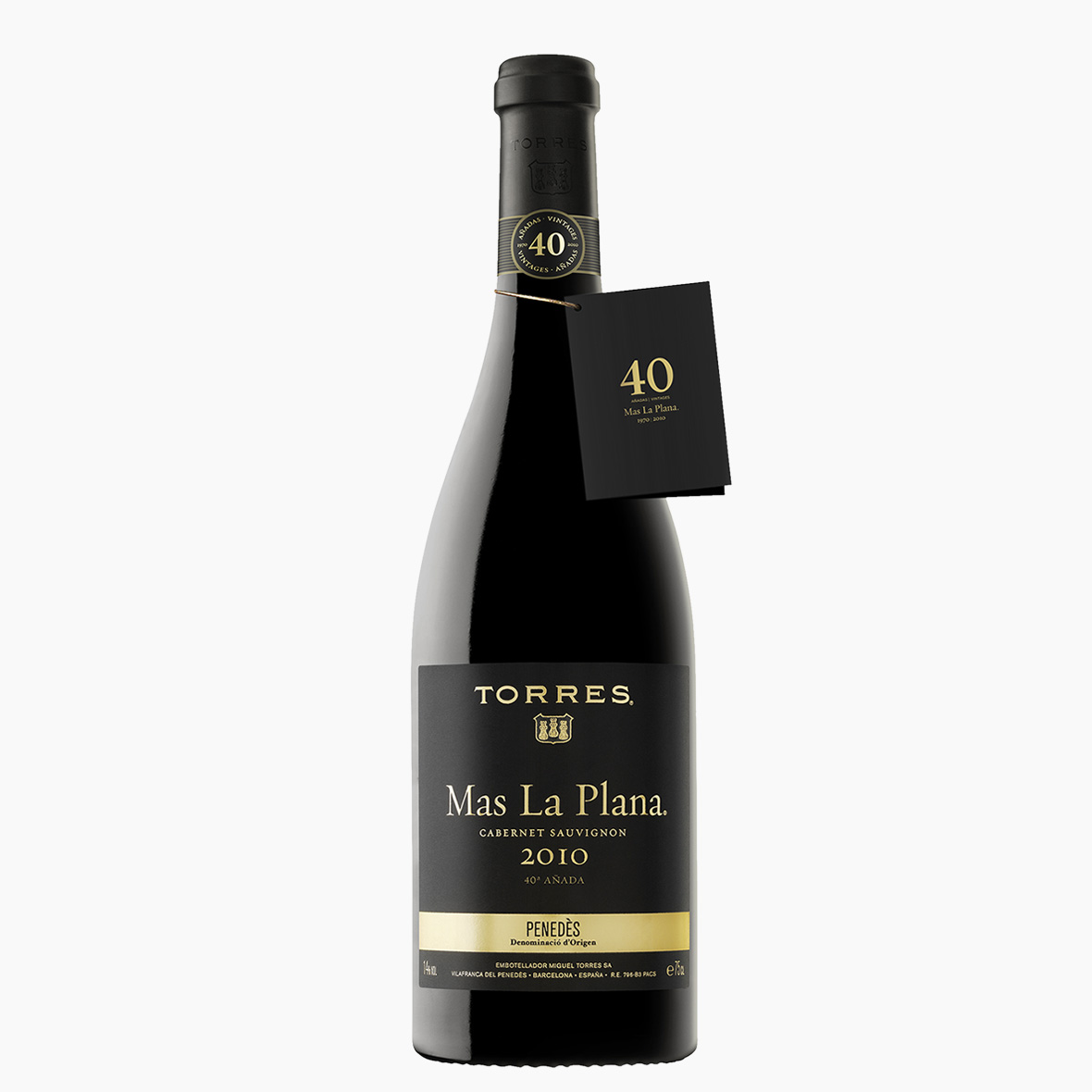 better
over the next five years.
better
over the next five years.
Porrera vi de Vila Vall Lach
Priorat 2011 ($65)—When I
mentioned
“stylized” wines, I meant wines like this Priorat,
which the label says
“denotes not only a region but celebrates the
unique terroir of a particular
village,” where old-vine Carignan is produced. The bottle itself is thick
and heavy and the alcohol soars
to 15.5%, making this a massive, two-dimensional
wine of fruit and tannin (70%
Carignan, 30% Garnacha) that raised my eyebrows
after the first sip but then I
wagged my head after the second.
It is deliberately made to be, as The
Donald might say, huge! As one wine magazine wrote,
it tastes of “tar and rhubarb,”
while another rightly says, it is “not for
the faint of heart’—neither of which sounds to me
like a well-made, balanced
Priorat
❖❖❖
CRIMES OF
PASSION, ALBUQUERQUE DIVISION
Police in Albuquerque, NM, arrested a 23-year-old named Jonathan
Ray who wanted his mother's homemade stew so badly
that he broke into her house and stole it. Ray
said he was stopping by for some of her pozole, but
she said no. So he jimmied the gate, did some
damage on the garage door to get inside the empty
house, then "He opened the door and grabbed that big
pot of posole I had made for my kids," his mom told
the Albuquerque Journal. "He knew I had made
it." She decided to press charges "due to the fact
that he did not have her permission to enter her
home and take the pot of posole."

EXACTLY WHAT WE
MARVELED!
“Under
Tuscan lemon chicken ($20) — browned, bone-in and
skin-on, natch — an unctuous four-cheese polenta shines
in a fond-rich mushroom demiglace. Milky, plump diver
scallops ($30), more rustico-protein, are oozy and
caramelized from a screaming-hot sear and piled on a
farro risotto hill (spared the "farrotto" portmanteau).
The light and bright spicy butternut squash sugo sauce
mirrors the scallops' sweetness, but the risotto is
surprisingly loose, the farro chewy. I marvel that the
whole get up looks like a motte-and-bailey castle with a
safety-yellow moat.”—Susie Davidson Powell, “Campagna,”
Times-Union
(12/15).
Any of John Mariani's books below may be ordered from amazon.com.
 I'm proud and happy to announce that my
new book, The Hound
in Heaven (21st Century Lion Books), has just
been published through Amazon and Kindle.
I'm proud and happy to announce that my
new book, The Hound
in Heaven (21st Century Lion Books), has just
been published through Amazon and Kindle. It is a novella, and for anyone who loves dogs, Christmas, romance, inspiration, even the supernatural, I hope you'll find this to be a treasured favorite. The story concerns how, after a New England teacher, his wife and their two daughters adopt a stray puppy found in their barn in northern Maine, their lives seem full of promise. But when tragedy strikes, their wonderful dog Lazarus and the spirit of Christmas are the only things that may bring back his master back from the edge of despair.
WATCH THE VIDEO!
“What a huge surprise turn this story took! I was completely stunned! I truly enjoyed this book and its message.” – Actress Ali MacGraw
“He had me at Page One. The amount of heart, human insight, soul searching, and deft literary strength that John Mariani pours into this airtight novella is vertigo-inducing. Perhaps ‘wow’ would be the best comment.” – James Dalessandro, author of Bohemian Heart and 1906.
“John Mariani’s Hound in Heaven starts with a well-painted portrayal of an American family, along with the requisite dog. A surprise event flips the action of the novel and captures us for a voyage leading to a hopeful and heart-warming message. A page turning, one sitting read, it’s the perfect antidote for the winter and promotion of holiday celebration.” – Ann Pearlman, author of The Christmas Cookie Club and A Gift for my Sister.
“John Mariani’s concise, achingly beautiful novella pulls a literary rabbit out of a hat – a mash-up of the cosmic and the intimate, the tragic and the heart-warming – a Christmas tale for all ages, and all faiths. Read it to your children, read it to yourself… but read it. Early and often. Highly recommended.” – Jay Bonansinga, New York Times bestselling author of Pinkerton’s War, The Sinking of The Eastland, and The Walking Dead: The Road To Woodbury.
“Amazing things happen when you open your heart to an animal. The Hound in Heaven delivers a powerful story of healing that is forged in the spiritual relationship between a man and his best friend. The book brings a message of hope that can enrich our images of family, love, and loss.” – Dr. Barbara Royal, author of The Royal Treatment.
 |
The Encyclopedia of American Food and Drink by John F. Mariani (Bloomsbury USA, $35) Modesty forbids me to praise my own new book, but let me proudly say that it is an extensive revision of the 4th edition that appeared more than a decade ago, before locavores, molecular cuisine, modernist cuisine, the Food Network and so much more, now included. Word origins have been completely updated, as have per capita consumption and production stats. Most important, for the first time since publication in the 1980s, the book includes more than 100 biographies of Americans who have changed the way we cook, eat and drink -- from Fannie Farmer and Julia Child to Robert Mondavi and Thomas Keller. "This book is amazing! It has entries for everything from `abalone' to `zwieback,' plus more than 500 recipes for classic American dishes and drinks."--Devra First, The Boston Globe. "Much needed in any kitchen library."--Bon Appetit. |
"Eating Italian will never be the same after reading John Mariani's entertaining and savory gastronomical history of the cuisine of Italy and how it won over appetites worldwide. . . . This book is such a tasteful narrative that it will literally make you hungry for Italian food and arouse your appetite for gastronomical history."--Don Oldenburg, USA Today. "Italian
restaurants--some good, some glitzy--far
outnumber their French rivals. Many of
these establishments are zestfully described
in How Italian Food Conquered the World, an
entertaining and fact-filled chronicle by
food-and-wine correspondent John F.
Mariani."--Aram Bakshian Jr., Wall Street
Journal.
"Equal parts
history, sociology, gastronomy, and just
plain fun, How Italian Food Conquered the
World tells the captivating and delicious
story of the (let's face it) everybody's
favorite cuisine with clarity, verve and
more than one surprise."--Colman Andrews,
editorial director of The Daily
Meal.com. "A fantastic and fascinating
read, covering everything from the influence
of Venice's spice trade to the impact of
Italian immigrants in America and the
evolution of alta cucina. This book will
serve as a terrific resource to anyone
interested in the real story of Italian
food."--Mary Ann Esposito, host of PBS-TV's
Ciao
Italia. "John Mariani has written the
definitive history of how Italians won their
way into our hearts, minds, and
stomachs. It's a story of pleasure over
pomp and taste over technique."--Danny Meyer,
owner of NYC restaurants Union Square
Cafe, The Modern, and Maialino.
|
 |
 |
 |
 |
 |
 |
 |
 |
 Everett Potter's Travel Report:
Everett Potter's Travel Report: 
 Eating Las
Vegas JOHN CURTAS has been covering
the Las Vegas food and restaurant scene
since 1995. He is the co-author of EATING LAS
VEGAS – The 50 Essential Restaurants (the
fourth edition of which will be published in
early 2016), as well as the author of the Eating Las
Vegas web site: www.eatinglasvegas.
He can also be seen every Friday morning as
the “resident foodie” for Wake Up With the
Wagners on KSNV TV (NBC) Channel 3 in
Las Vegas.
Eating Las
Vegas JOHN CURTAS has been covering
the Las Vegas food and restaurant scene
since 1995. He is the co-author of EATING LAS
VEGAS – The 50 Essential Restaurants (the
fourth edition of which will be published in
early 2016), as well as the author of the Eating Las
Vegas web site: www.eatinglasvegas.
He can also be seen every Friday morning as
the “resident foodie” for Wake Up With the
Wagners on KSNV TV (NBC) Channel 3 in
Las Vegas.

MARIANI'S VIRTUAL GOURMET
NEWSLETTER is published weekly. Editor/Publisher: John
Mariani.
Editor: Walter Bagley. Contributing Writers: Christopher Mariani,
Robert Mariani, Misha
Mariani,
John A. Curtas, Edward Brivio, Mort Hochstein,
Andrew Chalk, Dotty Griffith and Brian Freedman. Contributing
Photographers: Galina Dargery, Bobby
Pirillo. Technical Advisor: Gerry McLoughlin.
To un-subscribe from this newsletter,click here.
© copyright John Mariani 2016

